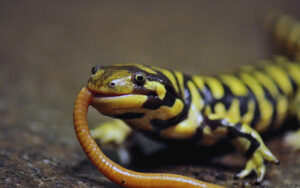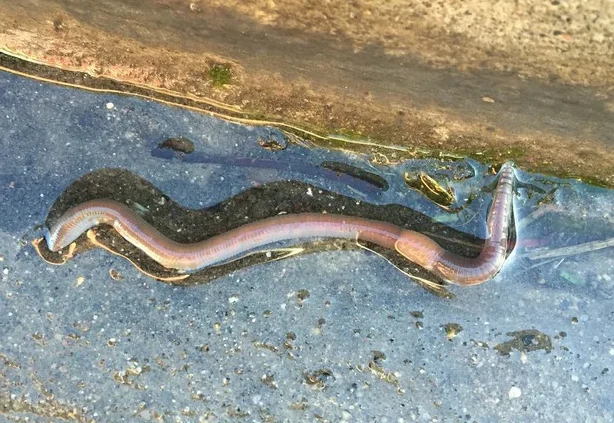If you’ve ever spotted a salamander crawling through damp leaves or hiding under a log, you might wonder, do salamanders eat worms?
Yes, they do. Worms are actually one of their favorite foods. But that’s just the beginning. Salamanders eat many different things, and their diet changes depending on where they live, what season it is, and how big they are.
Why Do Salamanders Love Worms?
Worms are perfect food for salamanders for a few simple reasons:
They’re easy to catch. Worms move slowly. They don’t run or fly away, which makes them easy targets.

They’re soft and nutritious. Worms are full of protein, and they’re easy to digest. Salamanders don’t have to chew or break through any hard shells.
They live in the same places. Worms love moist soil, leaf piles, and rotting logs, exactly the same places salamanders like to live and hunt.
For many salamanders, especially the ones that live on land, earthworms are a go-to meal. They’re the right size, full of nutrients, and easy to grab.
Which Salamanders Eat Worms?
Just about every land salamander will eat worms if given the chance. Here are a few that rely on them more often:
Eastern Tiger Salamanders live in fields and forests and hunt at night. They’re known to eat a lot of earthworms.

Red-backed Salamanders are small but active worm hunters. They live in forest leaf litter and follow scent trails to find their food.

Pet salamanders also eat worms. Many owners feed them earthworms because they’re easy to find in pet stores and provide great nutrition.
Even salamanders that live near water might eat worms if they can find them, especially aquatic worms or worms that get washed into streams.
What Else Do Salamanders Eat?
Worms are a big part of their diet, but they’re not the only thing salamanders eat.
- Salamanders eat ants, flies, beetles, and other small bugs.
- Spiders and mites. These small animals are perfect for tiny salamanders that live under logs.
- Slugs and snails. Soft, slow-moving, and easy to digest, just like worms.
- Tadpoles and small fish. Larger salamanders may go after prey that swims.
- Aquatic insects and tiny crustaceans. Stream-dwelling salamanders catch whatever drifts by.
- Other salamanders. In some cases, larger salamanders may eat smaller ones, even from their own species.

So while worms are a favorite, salamanders will eat just about anything small and slow enough to catch.
How Do Salamanders Hunt?
Most salamanders are quiet, patient hunters. They don’t chase their food. Instead, they sit and wait.
They hide under leaves, logs, or rocks. When something crawls by (a worm, a bug, or a spider) they strike.
They have sticky tongues. Many salamanders can shoot out their tongues to catch prey in an instant.
Others lunge and bite. If they don’t have a projectile tongue, they’ll quickly snap their jaws around the prey.
In water, it’s a little different. Aquatic salamanders use suction to catch food. They open their mouths quickly, creating a pull that draws in both water and prey.
No matter where they live, salamanders are quick, precise, and built for catching small animals like worms.
Where Do They Find Food?
The habitat plays a big role in what a salamander eats.
Forest salamanders search through damp leaves, rotting logs, and soft soil. That’s where most earthworms live.
Stream salamanders look for food in moving water, things like insect larvae, shrimp-like creatures, and tiny fish.
Underground salamanders rely on whatever they can find in the soil, mostly worms, grubs, and root-dwelling insects.
If a place is wet and full of small, wriggling animals, it’s probably good hunting ground for a salamander.
Do Salamanders Eat All Year Round?
Not always. Their feeding habits change with the seasons.
Spring and fall are the best times. The ground is moist, and there’s lots of prey. Salamanders are active and hunt regularly.
Summer can be tough, especially if it’s hot and dry. Salamanders might hide underground to stay cool and moist, and they eat less.
Winter is quiet time. In colder places, salamanders become inactive. They might hide in deep soil or under logs, eating very little or not at all.
Worms are also more common in cool, wet weather. That’s one more reason salamanders eat more in the spring and fall.
Do They Eat Dead Worms?
Salamanders prefer live food. They’re built to react to movement. If something is wiggling, it grabs their attention.
But if a salamander is very hungry and finds a freshly dead worm, it might eat it.
This is more common in young aquatic salamanders. Even so, most adults stick with live prey whenever they can.
Why Worms Matter to Salamanders, and Nature
Worms aren’t just easy meals. They’re part of a bigger picture.
When salamanders eat worms and insects, they help control the population of these animals. That keeps the ecosystem balanced.
At the same time, salamanders are food for other animals, birds, snakes, and mammals. So they’re right in the middle of the food web.
Because salamanders need clean water and healthy forests, scientists often use them to measure environmental health.
If salamanders disappear, it usually means something is wrong in the ecosystem.
Conclusion
Salamanders love worms, and for good reason. Worms are soft, easy to catch, full of protein, and found in the same damp places salamanders call home.
But worms are just one part of a much bigger diet. Salamanders also eat bugs, spiders, slugs, and even other salamanders. What they eat depends on where they live, what time of year it is, and how big they are.
By learning what salamanders eat, we understand more about how they survive, how they hunt, and how they fit into the natural world.
Whether they’re hunting in the soil, hiding under leaves, or swimming in a stream, salamanders play an important role in keeping ecosystems healthy.
The next time you see a salamander wriggling through the forest floor, there’s a good chance it’s on the lookout for a worm. And that simple meal is part of a much bigger story.
Hi, my name is Ezra Mushala, i have been interested animals all my life. I am the main author and editor here at snakeinformer.com.

